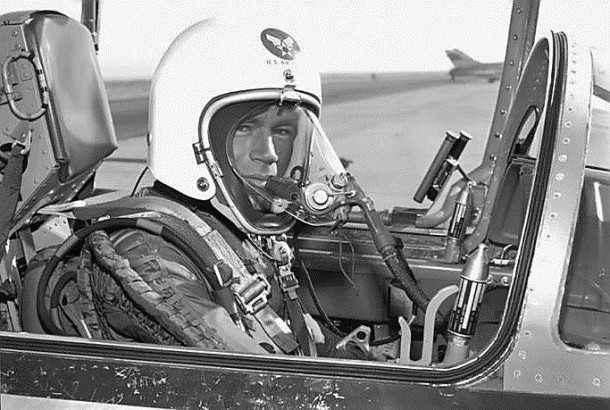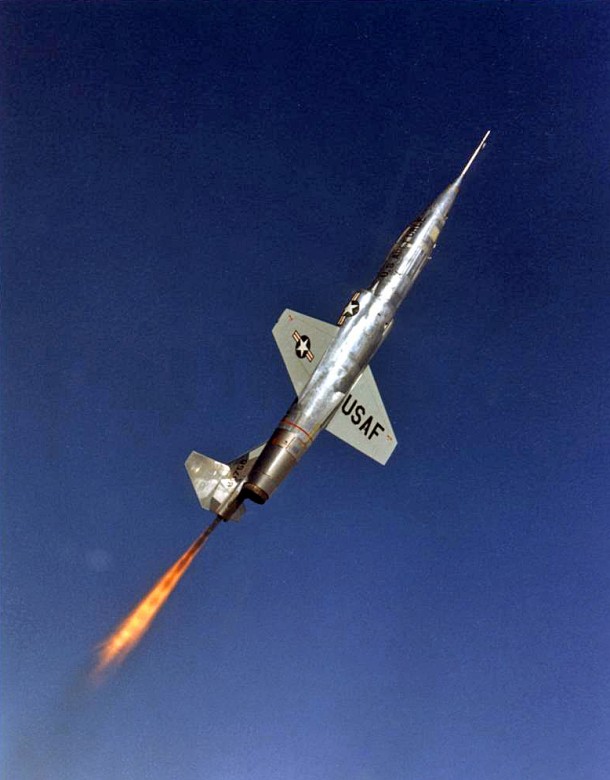
One-hundred and fourteen years ago this month, the Wright Flyer became the first aircraft in history to achieve powered flight. The site of this historic event was Kill Devil Hills located near Kitty Hawk, North Carolina.
Americans Wilbur and Orville Wright began their legendary aeronautical careers in 1899. In a matter of just four short years, the brothers would go from complete aeronautical novices to inventors and pilots of the world’s first successful powered aircraft. Neither man attended college nor received even a high school diploma.
The Wright Flyer measured roughly 21 feet in length and had a wing span of approximately 40 feet. The biplane aircraft had an empty weight of 605 lbs. Power was provided by a single 12 horsepower, 4-cylinder engine that drove twin 8.5 foot, two-blade propellers.
The Flyer made a powered take-off run along a 60-foot wooden guide rail. The aircraft was mounted on a two-wheel dolly that rode along the track and was jettisoned at lift-off. The Flyer pilot lay prone in the middle of the lower wing. Twin elevator and rudder surfaces provided pitch and yaw control, respectively. Roll control was via differential wing warping.
The Wright Brothers had come close to achieving a successful powered flight with the Wright Flyer on Monday, 14 December 1903. Wilbur, who had won the coin toss, was the pilot for the initial attempt. However, the Flyer stalled and hit the ground sharply just after take-off. Wilbur was unhurt, but repair of the damaged aircraft would take two days.
The next attempt flight took place on Thursday, 17 December 1903. The weather was terrible. Windy and rainy. Even after the rain abated, the wind continued to blow in excess of 20 mph. The Wrights decided to fly anyway. It was now Orville’s turn as command pilot.
Orville took his position on the Flyer and was quickly launched into the wind. Once airborne, the aircraft proved difficult to control as it porpoised up and down along the flight path. Nonetheless, Orville kept the Flyer in the air for 12 seconds before landing 120 feet from the take-off point. Other than a damaged skid, the aircraft was intact and the pilot unhurt. Powered flight was a reality!
Three more flights followed on that momentous occasion as the two brothers alternated piloting assignments. The fourth flight was the longest in both time aloft and distance flown. With Wilbur at the controls, the Wright Flyer flew for 59 seconds and landed 852 feet from the take-off point.
The Wright Brothers father, Milton, would soon learn of the epic events that December day in North Carolina. Orville’s verbatim Western Union telegram message sent to Dayton, Ohio read:
Success four flights thursday morning all against twenty one mile wind started from level with engine power alone average speed through air thirty one miles longest 57 [sic] seconds inform press home Christmas.

Forty-nine years ago today, three American astronauts departed Earth to become the first men to orbit the Moon during the flight of Apollo 8. This epic mission also featured the first manned flight of the mighty Saturn V launch vehicle as well as history’s first super-orbital entry of a manned spacecraft.
Following the Apollo 1 tragedy in January of 1967, the United States would not fly another manned space mission until October 1968. That flight, Apollo 7, was a highly successful earth-orbital mission in which the new Block II Apollo Command Module was thoroughly flight-proven.
Notwithstanding Apollo 7’s accomplishments, only 14 months remained for the United States to meet the national goal of achieving a manned lunar landing before the end of the 20th century’s 7th decade. The view held by many in late 1968 was that an already daunting task was now unachievable in the narrow window of time that remained to accomplish it.
The pessimism about reaching the Moon before the end of the decade was easy to understand. The Saturn V moon rocket had not been man-rated. The Lunar Module had not flown. Lunar Orbit Rendezvous (LOR) was untried. Men had not even so much as orbited the Moon. Yet, history would record that the United States would find a way to accomplish that which had never before been achieved.
George Low, manager of NASA’s Apollo Spacecraft Program Office, came up with the idea. Low proposed that the first manned flight of the Saturn V be a trip all the way to the Moon. It was something that Low referred to as the “All-Up Testing” concept. The newly-conceived mission would be flown in December 1968 near Christmas time.
While initially seen as too soon and too risky by many in NASA’s management hierarchy, Low’s bold proposal was ultimately accepted as the only way to meet the national lunar landing goal. Yes, there was additional risk. However, the key technologies were ready, the astronauts were willing, and the risk was acceptable.
Apollo 8 lifted-off from LC-39A at the Kennedy Space Center in Florida on Saturday, 21 December 1968 at 12:51 hours UTC. The crew consisted of NASA astronauts Frank Borman, James A. Lovell, Jr. and William A. Anders. Their target – the Moon – was 220,000 miles away.
After a 69-hour outbound journey, Apollo 8 entered lunar orbit on Tuesday, 24 December 1968 – Christmas Eve. The Apollo 8 crew photographed the lunar surface, studied the geologic features of its terrain, and made other observations from a 60-nautical mile circular orbit. The spacecraft circled the Moon 10 times in slightly over 20 hours.
For many, the most poignant and memorable event in Apollo 8’s historic journey occurred on Christmas Eve night when each of the flight crew took turns reading from the Book of Genesis in the Holy Bible. The solemnity of the moment was evident in the voices of the astronauts. They had seen both the Moon and the Earth from a perspective that none before them had. Fittingly, they expressed humble reverence for the Creator of the Universe on the anniversary of the birth of the Redeemer of mankind.
Apollo 8 departed lunar orbit a little over 89 hours into the mission. Following a nearly 58-hour inbound trip, Apollo 8 reentered the earth’s atmosphere at 36, 221 feet per second on Friday, 27 December 1968. The first manned super-orbital reentry was performed in total darkness. It was entirely successful as Apollo 8 landed less than 1 nautical mile from its target in the Pacific Ocean. The USS YORKTOWN effected recovery of the weary astronauts and their trustworthy spacecraft. Mission total elapsed time was 147 hours and 42 seconds.
The year 1968 was a tumultuous one for the United States of America. Martin Luther King and Robert Kennedy had been assassinated. American military blood flowed on the battlefields of Vietnam and civilian blood was let in countless demonstrations taking place in the nation’s cities. The ill-posed sexual revolution continued to eat away at the country’s moral moorings.
But, as is so often the case, an event from the realm of flight, now newly extended to lunar space, reminded us of our higher nature and potential. For a too brief moment, Apollo 8 put our collective purpose for being here into sharp focus. Perhaps a short phrase in a telegram sent to Frank Borman from someone he had never met said it best: “You saved 1968!”
However, looking through the lens of history, we now know that Apollo 8 did much more than end the penultimate year of the 1960’s on a positive note. Indeed, it may be said that Apollo 8 saved the entire Apollo Program.

Fifty-eight years ago this week, USAF Captain Joe B. Jordan zoomed a modified USAF/Lockheed F-104C Starfighter to a world altitude record of 103,395.5 feet above mean sea level. The flight originated from and recovered to the Air Force Flight Test Center (AFFTC) at Edwards Air Force Base, California.
On Tuesday, 14 July 1959, the USSR established a world altitude record for turbojet-powered aircraft when Soviet test pilot Vladimir S. Ilyushin zoomed the Sukhoi T-43-1 (a prototype of the Su-9) to an absolute altitude of 94,661 feet. By year’s end, the Soviet achievement would be topped by several American aircraft.
FAI rules stipulate that an existing absolute altitude record be surpassed by at least 3 percent for a new mark to be established. In the case of the Soviet’s 1959 altitude record, this meant that an altitude of at least 97,501 feet would need to be achieved in a record attempt.
On Sunday, 06 December 1959, USN Commander Lawrence E. Flint wrested the months-old absolute altitude record from the Soviets by zooming to 98,561 feet. Flint piloted the second USN/McDonnell Douglas YF4H-1 (F4 Phantom II prototype) in accomplishing the feat. In a show of inter-service cooperation, the record flight was made from the AFFTC at Edwards Air Force Base.
Meanwhile, USAF was feverishly working on its own record attempt. The aircraft of choice was the Lockheed F-104C Starfighter. However, with the record now held by the Navy, the Starfighter would have to achieve an absolute altitude of at least 101,518 feet to set a new mark. (Per the FAI 3 percent rule.)
On Tuesday, 24 November 1959, the AFFTC accepted delivery of the record attempt aircraft, F-104C (S/N 56-0885), from the Air Force Special Weapons Center at Kirtland AFB in New Mexico. This aircraft was configured with a J79-GE-7 turbojet capable of generating nearly 18,000 pounds of sea level thrust in afterburner.
Modifications were made to the J79 to maximize the aircraft’s zoom kinematic performance. The primary enhancements included increasing afterburner fuel flow rate by 10 percent and maximum RPM from 100 to 103.5 percent. Top reset RPM was rated at 104.5 percent. Both the ‘A’ and ‘B’ engine flow bypass flaps were operated in the open position as well. These changes provided for increased thrust and stall margin.
An additional engine mod involved reducing the minimum engine fuel flow rate from 500 to 250 pounds per hour. Doing so increased the altitude at which the engine needed to be shut down to prevent over-speed or over-temperature conditions. Another change included increasing the maximum allowable compressor face temperature from 250 F to 390 F.
The F-104C external airframe was modified for the maximum altitude mission as well. The compression cones were lengthened on the bifurcated inlets to allow optimal pressure recovery at the higher Mach number expected during the record attempt. High Mach number directional stability was improved by swapping out the F-104C empennage with the larger F-104B tail assembly.
USAF Captain Joe B. Jordan was assigned as the altitude record attempt Project Pilot. USAF 1st Lt and future AFFTC icon Johnny G. Armstrong was assigned as the Project Engineer. Following an 8-flight test series to shake out the bugs on the modified aircraft, the record attempt proper started on Thursday, 10 December 1959.
On Monday, 14 December 1959, F-104C (S/N 56-0885) broke the existing absolute altitude record for turbojet-powered aircraft on its 5th attempt. Jordan did so by accelerating the aircraft to Mach 2.36 at 39,600 feet. He then executed a 3.15-g pull to an inertial climb angle of 49.5 degrees. Jordan came out of afterburner at 70,000 feet and stop-cocked the J79 turbojet at 81,700 feet.
Roughly 105 seconds from initiation of the pull-up, Joe Jordan reached the top of the zoom. The official altitude achieved was 103,395.5 feet above mean sea level based on range radar and Askania camera tracking. True airspeed over the top was on the order of 455 knots. Jordan started the pull-up to level flight at 60,000 feet; completing the recovery at 25,000 feet. Landing was entirely uneventful.
Jordan’s piloting achievement in setting the new altitude record was truly remarkable. His conversion of kinetic energy to altitude (potential energy) during the zoom was extremely efficient; realizing only a 2.5 percent energy loss from pull-up to apex. Jordan also exhibited exceptional piloting skill in controlling the aircraft over the top of the zoom where the dynamic pressure was a mere 14 psf. He did so using aerodynamic controls only. The aircraft did not have a reaction control system ala the X-15.
Armstrong’s contributions to shattering the existing altitude record were equally substantial. Skillful flight planning and effective use of available resources (including time available for the record attempt) were pivotal to mission success. Armstrong significantly helped maximize aircraft zoom performance through proper selection of pull-up flight conditions and intelligent use of accurate day-of-flight meteorological information.
For his skillful piloting efforts in setting the world absolute altitude record for turbojet-powered aircraft in December of 1959, Joe Jordan received the 1959 Harmon Trophy.

Fifty-four years ago today, USAF Major Robert W. Smith zoomed the rocket-powered Lockheed NF-104A to an unofficial world record altitude of 120,800 feet. This mark still stands as the highest altitude ever achieved by a United States aircraft from a runway take-off.
A zoom maneuver is one in which aircraft kinetic energy (speed) is traded for potential energy (altitude). In doing so, an aircraft can soar well beyond its maximum steady, level altitude (service ceiling). The zoom maneuver has both military and civilian flight operations value.
The USAF/Lockheed NF-104A was designed to provide spaceflight-like training experience for test pilots attending the Aerospace Research Pilot School (ARPS) at Edwards Air Force Base, California. The type was a modification of the basic F-104A Starfighter aircraft. Three copies of the NF-104A were produced (S/N’s 56-0756, 56-0760 and 56-0762). It was the ultimate zoom flight platform.
In addition to a stock General Electric J79-GE-3 turbojet, the NF-104A was powered by a Rocketdyne LR121-NA-1 rocket motor. The J79 generated 15,000 pounds of thrust in afterburner and burned JP-4. The LR-121 produced 6,000 pounds of thrust and burned a combination of JP-4 and 90% hydrogen peroxide. Rocket motor burn time was on the order of 90 seconds.
The NF-104A was kinematically capable of zooming to altitudes approaching 125,000 feet. As such, it was a combined aircraft, rocket, and spacecraft. The pilot had to blend aerodynamic and reaction controls in the low dynamic pressure environment near the zoom apex. He was also required to fly in a full pressure suit for survival at altitudes beyond the Armstrong Line.
On Friday, 06 December 1963, Bob Smith took-off from Edwards and headed west for the Pacific Ocean. Out over the sea, he changed heading by 180 degrees in preparation for the zoom run-in. At a point roughly 100 miles out, Smith then accelerated the NF-104A (S/N 56-0760) along a line that would take him just north of the base. Arriving at Mach 2.4 and 37,000 feet, Smith then initiated a 3.75-g pull to a 70-degree aircraft pitch angle. Turbojet and rocket were at full throttle.
Things happened very quickly now. Smith brought the turbojet out of afterburner at 65,000 feet and then moved the throttle to the idle detent at 80,000 feet. The rocket motor burned-out around 90,000 feet. Smith controlled the aircraft (now spacecraft) over the top of the zoom using 3-axis reaction controls. The NF-104A’s arcing parabolic trajectory subjected him to 73 seconds of weightlessness. Peak altitude achieved was 120,800 feet above mean sea level.
On the back side of the zoom profile, Bob Smith restarted the windmilling J79 turbojet and set-up for landing at Edwards. He touched down on the main runway and rolled out uneventfully. Total mission time from brake-release to wheels-stop was approximately 25 minutes.
Much more could be said about the NF-104A and its unique mission. Suffice it to say here that two of the aircraft ultimately went on to serve in the ARPS from 1968 to 1971. The only remaining aircraft today is 56-0760 which sits on a pole in front of the USAF Test Pilot School (TPS) at Edwards.
Bob Smith went on to make many other noteworthy contributions to aviation and his nation. Having flown the F-86 Sabre in Korea, he volunteered to fly combat in Viet Nam in his 40th year. Stationed at Korat AFB in Thailand, he commanded the 34th Fighter Squadron of the 388th Tactical Fighter Wing. Smith flew 100 combat missions in the fabled F-105D Thunderchief; many of which involved the infamous Pack VI route in North Viet Nam.
Bob Smith was a true American hero. Like so many of the airmen of his day, Smith was a man whose dedication, service, and courage went largely unnoticed and underappreciated by his fellow countrymen. Bob Smith’s final flight came just 3 months shy of his 82nd birthday on Thursday, 19 August 2010.





